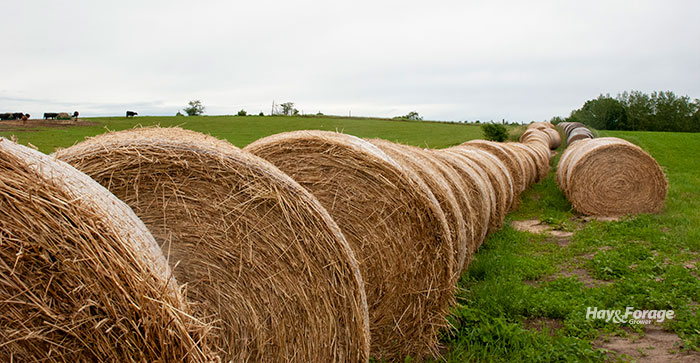Got enough bales? |
| By C.J. Weddle |
|
|
 Some cattle farmers will have to worry more than others if they have enough hay to last through the winter months. Oklahoma State University Emeritus Extension Animal Scientist Glenn Selk explains that estimating potential forage use is an important part of calculating winter feed needs. Forage quality plays a large role in how much cattle will consume daily and, therefore, how much will be needed during the winter months. Higher quality forages, containing 8% or more crude protein, will ferment in the rumen more quickly than forages that contain less than 6% crude protein. Because the high-quality forages ferment faster, a void is left in the rumen, which animals will refill by eating more hay. Selk offers the following rules of thumb for feeding rates based on forage quality: • Low-quality forages (below about 6% crude protein) will be consumed at about 1.5% of body weight (on a dry matter basis) per day. • High-quality grass hays (above 8% crude protein) may be consumed at about 2% of body weight. • Excellent forages, such as good alfalfa, silages, or green pasture may be consumed at the rate of 2.5% of body weight per day. With these dry matter intake estimates, producers can begin to figure the amount of winter forages needed for their herd. “The combination of increased nutrient content and higher forage intake makes high-quality forage very valuable to the animal and the producer,” Selk notes. More factors to consider A few more things to keep in mind when calculating winter forage needs are the hay dry matter/moisture content; hay wastage; average animal weight; and animal condition, as in open, pregnant, or lactating. Each progressive condition requires more nutrition and, therefore, more winter forage inventory. Knowing the average weight of your round bales will be an important factor as well. Selk offers an example of a 1,200 pound, pregnant, spring-calving cow. Assuming that the grass hay quality is good and tested 8% crude protein, the cow will voluntarily consume 2% of body weight, or 24 pounds per day. The 24 pounds is based on 100% dry matter, but grass hay will often be 7% to 10% moisture. If we assume that the hay is 92% dry matter or 8% moisture, then the cow will consume about 26 pounds per day on an "as-fed” basis. “Unfortunately, we also have to consider hay wastage when feeding big round bales,” Selk notes. “Hay wastage is difficult to estimate but generally has been found to be from 6% to 20% or more.” Selk assumes 15% hay wastage for his example. This means that approximately 30 pounds of grass hay must be hauled to the pasture for each pregnant cow each day that hay is expected to be the primary ingredient in the diet. How many days? Finally, be aware of how you long you will typically need to feed winter forages. Winter feeding will correlate to your region’s growing seasons and productivity. Several questions need to answered: When do I need to begin winter feedings? How much was I able to stockpile in standing forages? When will new spring forages be available to graze? Once these variables are determined, then estimate the amount of forage needed to sustain your herd throughout the winter months.  C.J. Weddle C.J. Weddle served as the 2020 Hay & Forage Grower editorial intern. She currently attends Mississippi State University, majoring in agricultural education, leadership, and communications. She grew up on a farm in Vardaman, Miss., where her family raises sweet potatoes and soybeans.
|
